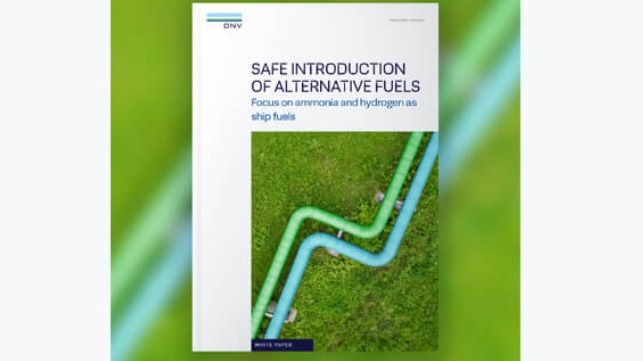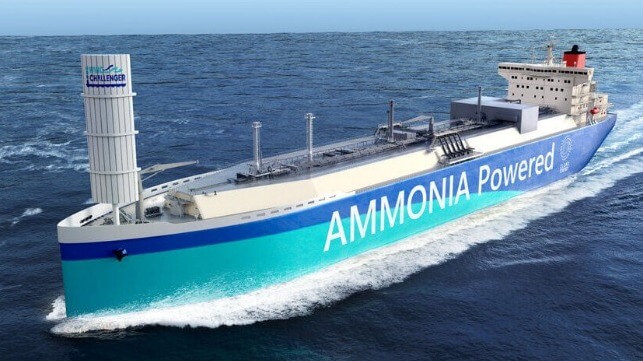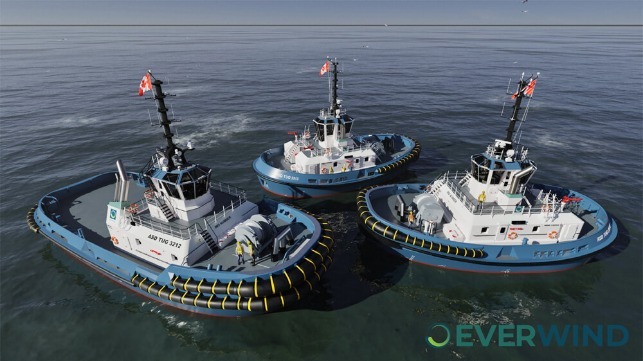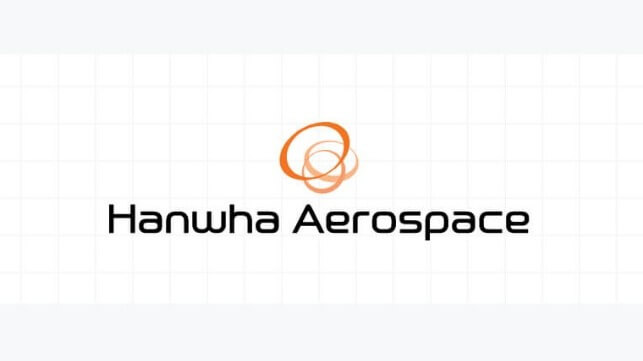ALT. FUELS
DNV White Paper on Safe and Scalable Adoption of Ammonia and Hydrogen Fuels

As the shipping industry continues its transition to carbon-neutral fuels, ammonia and hydrogen are emerging as possible fuel options, however mandatory regulations governing their use are not yet in place. DNV’s latest white paper, Safe introduction of alternative fuels – Focus on ammonia and hydrogen as ship fuels, provides shipowners with insights and tools to navigate the evolving regulatory landscape and safely implement these fuels.
Both hydrogen and ammonia have properties that introduce new safety risks, triggering the need for increased focus on safety in ship design, construction, and operation. However, the lack of specific mandatory international regulations for ships running on these fuels is a barrier to their widespread adoption. With it’s latest white paper DNV aims to support customers in implementing these fuels by providing increased predictability through classification rules and early dialogue with Flag Administrations. The paper also outlines the relevant safety challenges and considers the industry's efforts to ensure safe adoption and operation of these fuels at sea.
Knut Ørbeck-Nilssen, CEO Maritime at DNV said: "In Maritime’s journey towards decarbonization, there is no one-size-fits-all solution. Hydrogen and ammonia are emerging as possible solutions, and we are already seeing a growing newbuilding orderbook. To scale them up and get the benefits of the zero-carbon fuels, we will need, careful planning, technical expertise, upskilling of seafarers and deeper collaboration across the industry and beyond."
DNV is leading several initiatives to support the development and adoption of ammonia and hydrogen as marine fuels. These include the Nordic Roadmap for Future Fuels project, the Green Shipping Programme, and the MarHySafe joint development project.
Linda Hammer, Principal Engineer at DNV and lead author of the whitepaper, stated: "To safely operate ships using hydrogen or ammonia as fuel, ensuring that the crew understands the specific hazards of these fuels and the safety features built into the design is vital. This will require updates to the safety management system, building in detailed operating procedures, comprehensive training for up-skilling personnel, and potentially making organizational changes. All of which are essential for developing a robust safety culture throughout the organization."
DNV has developed prescriptive classification rules as far as possible, aimed at ensuring increased predictability for owners, designers, and shipyards. The first edition of the classification rules for ammonia-fuelled ships was published in 2021, and the rules for hydrogen-fuelled ships were published in July 2024.
Read the full whitepaper here
The products and services herein described in this press release are not endorsed by The Maritime Executive.
Japanese Partners Advance Designs for Large Ammonia Carrier

A partnership of Japanese companies continues to accelerate its efforts to develop ammonia transport as the efforts continue to move forward to complete the development of ammonia as a fuel for industry and the maritime sector. The designs received initial design approval from ClassNK (Nippon Kaiji Kyokai, which reviewed the basic design drawings and risk assessment in awarding Approval in Principle (AiP).
The project is a partnership between Mitsubishi Shipbuilding Co., Mitsui O.S.K. Lines, and Namura Shipbuilding Co. They highlight to respond quickly to future demands, the designs have been completed in more detail than generally required for the AiP process. They are focusing on the market potential as a transitional fuel for power plans and the maritime sector as well as a hydrogen carrier.
Mitsubishi Shipbuilding, Mitsui O.S.K. Lines, and Namura Shipbuilding have been working to develop a basic design for a large ammonia carrier. They report that the vessel is intended to have an engine that utilizes ammonia as the main fuel source, aiming to reduce greenhouse gas emissions from the vessel. In addition, the rendering incorporates the rigid sail system, Wind Challenger, which was developed by Mitsui O.S.K. Lines and Oshima Shipbuilding Co. and first deployed in 2022.
The ship is designed to be even larger than the conventional segment for Very Large Gas Carrier/Very Large Ammonia Carrier (VLGC/VLAC) vessels. According to the project, this will enhance the efficiency of marine transport.
The revolutionary ship design they report satisfies the port entry restrictions at major power plants in Japan. It ensures compatibility between ammonia loading/unloading terminals, and cargo handling connections at a level almost equivalent to existing VLGCs.
It is anticipated that the first vessels could be built in the second half of this decade.
EverWind Invests in New Low-Emission Tugboats Built by Damen

EverWind Fuels announced an investment of approximately $50 million to launch a new three-vessel fleet of advanced, lower-emission tugboats in the Strait of Canso. The modernized vessels will help enhance maritime sustainability, improve infrastructure reliability, and support green shipping corridors in Nova Scotia. This project, one of the largest private sector investments in the Strait of Canso in the last 50 years, will have a significant impact on the local economy, creating good long-term jobs and leveraging the experience and expertise of local skilled workers to strengthen Nova Scotia’s position as a leader in sustainable maritime operations.
The investment will be supported by an expansion of EverWind’s Marine Team by approximately 15 new local employees responsible for safety and tugboat operations. These new advanced vessels will be owned locally and will replace EverWind’s contracted fleet of three tugboats which were built between 1992 and 2004, aligning with Canada’s clean energy transition and reinforcing EverWind’s commitment to innovation, efficiency and environmental responsibility.
The state-of-the-art vessels are required to facilitate specialized operations associated with the transportation of green hydrogen and ammonia produced at Point Tupper, establishing a regional export hub to reach lucrative clean fuel markets. The vessels will continue to be used to support existing industries operating in the Strait of Canso, serving as a valuable asset in the local marine sector.
Purpose-built and designed for local use, the new tugboats are expected to arrive in the summer of 2025 and will be in full compliance with International Maritime Organization (IMO) Tier III emissions standards, the most stringent emissions standards for the international marine industry. These standards were designed to improve air quality and protect public health by controlling emissions from ships.
Greenhouse gas emissions from the new vessels will be significantly lower than the current fleet, delivering reduction of approximately 80 per cent in nitrogen oxides (NOx) and 25 per cent in CO2, significantly lowering the environmental impact of marine operations in the Strait of Canso. EverWind is working with its maritime partners on a longterm plan to further transition its tugboats toward zero carbon emissions as EverWind’s renewable power generation and ammonia production projects come online.
The Point Tupper Marine Terminal plays a vital role in supporting safe, efficient maritime operations with its critical infrastructure. EverWind’s new low-emission vessels will strengthen port capabilities while maintaining a strong commitment to environmental stewardship and delivering tangible economic benefits to Strait Area communities.
Quotes
Trent Vichie, Founder and CEO, EverWind
“This investment is a critical step in enabling large-scale green hydrogen and ammonia production with our international partners. By integrating new advanced tugboats into our operations following the strictest IMO emissions standards we’re ensuring safe, efficient, and sustainable maritime logistics that support the international transition to clean energy. EverWind is proud to lead the charge in building the infrastructure needed to position Nova Scotia as a key global hub for green hydrogen and ammonia exports.”
Mike Kelloway, Member of Parliament for Cape Breton–Canso
“This investment by EverWind is a testament to the positive impact that innovative technologies can have on our environment and our communities. By supporting cleaner maritime transportation, we're not only creating jobs for our youth and strengthening our economy but also ensuring a more sustainable future for Cape Breton Island.”
David Hart, Manager, Point Tupper Marine Services
“EverWind’s leadership in green shipping will have a lasting impact on our region. These new vessels will support local industry, create jobs, and move us forward setting new standards for sustainable marine operations in Nova Scotia.”
Lois Landry, Richmond County Warden and Councillor for District 2
“This investment is a significant win for our local communities, creating stable, long-term jobs in the Strait Area and strengthening rural economies. By leveraging the skills and expertise of our local workforce, EverWind is ensuring that the benefits of its green hydrogen and ammonia projects remain right here in our region, supporting families, businesses, and future generations.”
Brenda Chisholm-Beaton, Mayor, Port Hawkesbury
“EverWind’s investment is great news for our community, creating new, good, long-term jobs and strengthening our local economy. The Strait of Canso has long been a hub for industry and innovation, and these new vessels will ensure that tradition continues while paving the way for future clean energy development. This project is a key step in building a stronger, more sustainable future for our region, and I’m excited to see the opportunities it will bring for local workers, businesses, and families in our community.”
Quick Facts
The new fleet of vessels will consist of a Damen ASD 3212 Tug and two Damen RSD 2513 Tugs. Damen was selected to build the new fleet after an extensive selection process. The vessels will measure 32 metres and 25 metres in length, with 80 tonnes and 65 tonnes of bollard pull, providing greater maneuverability and power to the Strait of Canso maritime operations.
The Strait of Canso is a critical hub for global trade, known for its world-class, deep-water, ice-free berths, strategic location, and established industrial base. The region is home to some of Atlantic Canada’s largest industrial users, supporting energy production, manufacturing, and international shipping.
The products and services herein described in this press release are not endorsed by The Maritime Executive.
Hanwha Aerospace Receives DNV AIP Certification on Hydrogen Fuel Cells

- Global Authority DNV Validates Top-Tier Safety and Performance Standards
- Second Major Certification Following Korean Register Approval Last Year
- Company Positioned to Advance Zero-Carbon Maritime Propulsion Technology
Hanwha Aerospace announces that it has received Approval in Principle (AIP) certification from DNV for its 200kW hydrogen fuel cell system designed for maritime applications, marking a significant milestone in the company's official entry into the eco-friendly zero-carbon vessel market. This achievement follows the company's development of the world's first liquid-cooled Energy Storage System (ESS) late last year, securing consecutive world-class zero-carbon power solutions.
The certification ceremony took place on the 12th at Hanwha Aerospace's R&D Center in Pangyo, with Executive Director Dong-jo Oh of Hanwha Aerospace and Vice President Sung-ho Shin of DNV in attendance, the company announced on the 13th.
AIP certification verifies the safety and compliance with international regulations of new technologies applied to ships and materials during the basic design phase. This rigorous evaluation process ensures that innovative marine technologies meet the highest standards of safety and performance before implementation.
"This certification from DNV validates our hydrogen fuel cell technology at the highest global standards for safety and performance," said Dong-jo Oh, Executive Director of Hanwha Aerospace. "We will leverage our eco-friendly marine solution technologies to continuously collaborate with Hanwha Ocean in targeting the global zero-carbon vessel market, helping the maritime industry achieve significant reductions in carbon emissions."
This latest certification builds upon Hanwha Aerospace's previous success in obtaining AIP certification from the Korean Register of Shipping (KR) last year. With validation now from both KR and DNV, Hanwha Aerospace is positioned to begin full-scale marketing and sales of its maritime hydrogen fuel cells in the global market.
With this certification, Hanwha Aerospace is positioned to secure type approval for its Polymer Electrolyte Membrane Fuel Cell (PEMFC) technology, strengthening its competitiveness in the zero-carbon propulsion systems market. The company plans to further develop and commercialize this technology for various marine vessels, from commercial ships to specialized maritime applications.
The products and services herein described in this press release are not endorsed by The Maritime Executive.
No comments:
Post a Comment